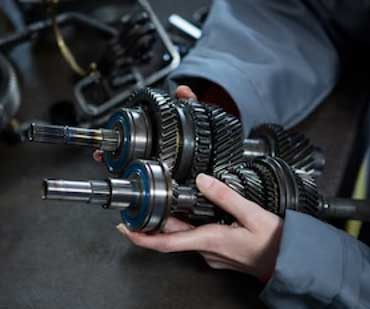Importance of Precision Thickness for Shims in Manual Transmission Assembly
As mechanical technology continues to evolve, understanding the intricacies of its components becomes increasingly important. This article delves into the realm of manual transmission assembly, with particular focus on the critical role of precision thickness for shims.
Introduction to Manual Transmission Assembly
Manual transmission assembly is the heart of vehicles that require human intervention to shift gears. Being an intricate system, it involves various components working in harmony to ensure smooth gear shifting and optimal performance. One of the lesser-known but crucial components in this assembly are precision thickness shims.
Shims come in various forms and sizes, but their primary function remains constant – to fill in gaps or adjust spacing between other components. In the context of a manual transmission, shims play an essential role in ensuring the precise alignment and spacing of parts. This alignment is crucial for the overall efficiency of the transmission system because even a slight misalignment can result in significant wear and tear.
In the subsequent sections, we will delve into the specifics of precision shims, their role in manual transmission assembly, and why their precision thickness is of utmost importance.
Understanding Precision Shims
Precision shims, as the name suggests, are designed and manufactured with high accuracy. They are typically used in applications where exact spacing or alignment is required. Their precision thickness ensures that they provide the necessary clearance or fill the gap exactly as needed.
Their importance in the manual transmission assembly cannot be overstated. They maintain the correct spacing between the various components of the transmission assembly, such as the gears, shafts, and bearings. Without these precision shims, these components might not align correctly, leading to inefficiency and accelerated wear and tear.
Moreover, the right thickness of precision shims is critical to their function. Too thin, and they might not provide the necessary clearance. Too thick, and they might push the components too far apart, causing misalignment.
Role of Precision Shims in Manual Transmission
In manual transmission assembly, precision shims are used to adjust the spacing between the various components. They ensure that all parts are positioned correctly relative to each other, which is crucial for the smooth operation of the transmission.
Shims serve as a buffer, reducing friction and wear and tear between parts. Their thickness is critical because it determines the amount of clearance between components. If the shim is too thick, it could lead to excessive clearance, resulting in a loose and inefficient assembly. Conversely, if it is too thin, the components could be too close together, leading to friction and wear.
Therefore, the precision thickness of shims is vital in maintaining the optimal performance of the manual transmission. It ensures that the entire assembly works efficiently and lasts longer.
Torque vs. Turn Ratio: Why Precision Matters
In manual transmission assembly, the relationship between torque and turn ratio is critical. Torque is the force that causes rotation, while the turn ratio is the relationship between the input (from the driver) and the output (to the wheels).
The precision thickness of shims plays a significant role in maintaining the right torque vs. turn ratio. Too much spacing (caused by overly thick shims) can reduce the torque, making the vehicle harder to drive. On the other hand, too little spacing (caused by overly thin shims) can result in excessive torque, making the vehicle difficult to control.
Hence, the right precision thickness of shims is crucial in achieving the optimal torque vs. turn ratio, ensuring a smooth and comfortable driving experience.
Importance of the Right Thickness in Precision Shims
The thickness of precision shims in manual transmission assembly is not just about ensuring the right spacing between components. It also directly impacts the performance and lifespan of your transmission.
The right thickness ensures that there’s adequate clearance between components, preventing unnecessary friction and wear. It also maintains the correct alignment and positioning of parts, ensuring efficient operation. Moreover, it contributes to achieving the optimal torque vs. turn ratio, significantly impacting the vehicle’s drivability.
Hence, the right precision thickness of shims is not just a technical specification. It’s a critical factor that determines the performance, efficiency, and longevity of your manual transmission.
Metal Spacers Role in Manual Transmission Assembly
Metal spacers are another essential component in manual transmission assembly. Like precision shims, they are used to adjust the spacing between components. However, they are typically larger and thicker than shims, and are used in areas where larger clearances are needed.
Despite their differences, both precision shims and metal spacers play a crucial role in manual transmission assembly. They work together to ensure proper spacing and alignment of all components, leading to efficient operation and prolonged lifespan of the transmission.
Roller Bearing Setting in Manual Transmission
Roller bearing setting is a critical process in manual transmission assembly. It involves adjusting the position of the roller bearings to ensure optimal contact with the raceways. This contact is crucial for the smooth and efficient operation of the transmission.
Precision shims play a significant role in this setting. They are used to adjust the positioning of the roller bearings, ensuring the correct contact angle. The right precision thickness of shims is crucial in this context, as it directly impacts the contact angle and, consequently, the performance of the transmission.
Effects of Precision Thickness on Performance
In real-world applications, the impact of precision thickness of shims on the performance of manual transmission is evident. A well-assembled transmission with the right precision thickness of shims provides a smooth and comfortable driving experience. It ensures the right torque vs. turn ratio, making the vehicle easy to drive and control.
On the other hand, a poorly assembled transmission with incorrect precision thickness of shims can lead to various problems. It can cause excessive wear and tear, reducing the lifespan of the transmission. It can also impact the drivability of the vehicle, making it harder to control.
Therefore, the right precision thickness of shims is not just a technical detail. It’s a critical factor that directly impacts the performance and lifespan of your manual transmission.
Choose the Right Shims for Your Manual Transmission Assembly
Choosing the right shims for your manual transmission assembly is a critical task. It involves understanding the specifications of your transmission and the requirements of the assembly.
The right precision thickness of shims depends on various factors, including the type and size of the transmission, the components involved, and the desired torque vs. turn ratio. It’s advisable to consult with an expert or refer to the manufacturer’s guidelines to ensure you choose the right shims.
Moreover, it’s essential to choose high-quality shims. Low-quality shims may not provide the desired precision thickness, leading to inefficiency and accelerated wear and tear.
Critical Role of Precision Thickness for Shims in Manual Transmission Assembly
In conclusion, the precision thickness of shims plays a critical role in manual transmission assembly. It ensures the right spacing and alignment of components, contributing to the efficient operation and prolonged lifespan of the transmission. It also impacts the torque vs. turn ratio, directly affecting the drivability of the vehicle.
Choosing the right precision thickness of shims is crucial. It involves understanding the requirements of your transmission and choosing high-quality shims that meet these requirements.
In the realm of manual transmission assembly, precision thickness for shims is not just a specification. It’s a critical factor that determines the performance, efficiency, and longevity of your transmission.
Therefore, whether you’re assembling a manual transmission or just maintaining one, understanding the importance of precision thickness for shims is essential.
Manual Transmission Precision Shim | Michigan
Now that you understand the critical role of precision thickness for shims in manual transmission assembly, it’s time to ensure your transmission is equipped with the right shims. If you need assistance, don’t hesitate to consult with the experts at Northern Industrial Manufacturing, in Michigan. Manual transmission, precision shim, torque vs. turn ratio, metal spacers, roller bearing setting – all these elements need the right attention to ensure the optimal performance of your vehicle.
Thank you for visiting our blog where we keep customers updated and informed on the latest processes in automotive parts manufacturing!
Please check back often if you would like to learn more about the world of precision thrust washers, selective shims, spacers, and other automotive parts.




